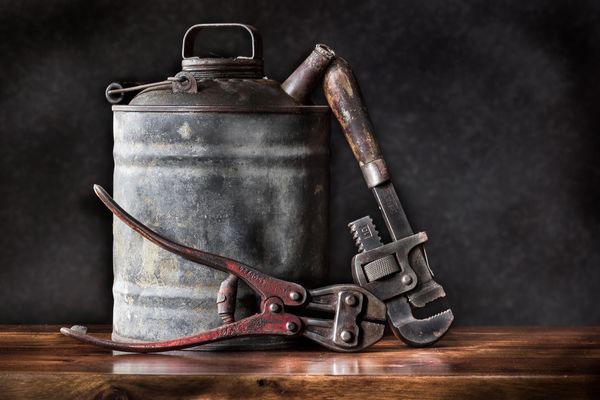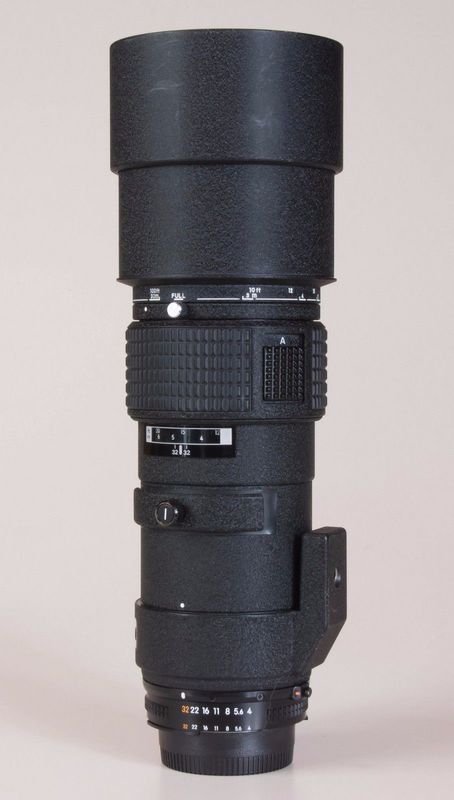Photographing household objects
Mar 22, 2017 09:58:13 #
photoman022
Loc: Manchester CT USA
Texcaster wrote:
For that size, a small light box will work. I've been learning studio work for instruments and furniture, still a long way to go. Wrinkles are a real worry with fabric and I'm going to vinyl.
How To Build A Photo Light Box For Less Than $10
https://www.youtube.com/watch?v=T6fnHEvLyAE
How To Build A Photo Light Box For Less Than $10
https://www.youtube.com/watch?v=T6fnHEvLyAE

 you showed what I would say
you showed what I would sayMar 22, 2017 10:33:04 #
mtstick wrote:
I do almost exclusively Sports photography and cu... (show quote)
Reflections on curved surfaces is a problem for even Pros. Try a CPL filter. That should help for the hot spots or catch lights on your wooden pieces. Though for future reference, PL or CPL filters will not help with metallic surfaces as that light is not polarized.
If you can afford it, get some sort of Soft Box lighting; create a light tent; or at least have a plain paper or cloth background.
I don't buy the need for flash. I've done "product shots" or "still life" which is what you have here (at home), fine with CFL or LED lights, Quartz, or even everyday incandescent bulbs. Color can be corrected easily if shot in Raw using Photoshop or Lightroom, and your camera has various White Balance settings including custom Kelvins. I used to work in a museum and we only used flash (with film) for location shots. Most "studio" and "copy" work was done with Constant Lighting.
Mar 22, 2017 11:10:51 #
mtstick wrote:
I do almost exclusively Sports photography and cu... (show quote)
HI I do commercial product shooting, I suggest that you take your photos with no distracting backgrounds, and use a solid white sheet ( or seamless paper), to cover the wall and the table. For an added touch you might consider putting a sheet of translucent plexiglass over the table sheet for any muted reflections . I would creatively manipulate the light so that you can create a nice shadow. I use a "key" light ( or you might use the light from a window) on the right, and overhead light as well. Then I put a reflector (any white board will do), to bounce the Key light back onto to the item. The plexiglass will give a subtle reflection. The over head will add light to areas that have deep shadow, as in the bowls. Its best not to make the backgrounds distract from the main interest.
Mar 22, 2017 11:47:17 #
Try using a Light Tent. They create a soft even light. You could Google them for different brands and sizes.
Mar 22, 2017 12:02:25 #
Take the setup suggestions here and try light painting the objects in a darkened room and then merge several exposures as layer masks in Photoshop or your favorite layering program. Lots of instruction on layering and masking exposures on the internet.

Mar 22, 2017 12:36:15 #
mtstick wrote:
I do almost exclusively Sports photography and cu... (show quote)
Your camera and lens are fine. Use a tripod.
If you are interested in showing off the artwork, do NOT shoot against an identifyable background. I have a piece of light gray and piece of light tan formica (30" wide, 8' long) that I use for on-site tabletop photography. I glued a string on one side so it could be mounted on the top of a door with a piece of heavy wire. then I place a small table 24-36" away from the door and drape the formica over it. Just make sure you have enough room for lights on either side. You can use strobes shooting through white umbrellas or soft boxes if you do this all the time. You can even use the quartz work-lights available at hardware stores through cheap, $10 white umbrellas (not too close!) if you don't do this often, but WB for 3200K. The advantage here is that you can see the items as they will appear better than with flash. Use a small enough f/stop to get good depth, but not so small for diffraction to become an issue.
If you have "shine" issues, art supply stores carry Krylon dulling spray which is easily removable with water for quite a while (1/2 hr or so) and will get rid of your reflections on round objects.
I worked for Sotheby's art auctions for many years doing mostly tabletops, so I have some idea of your problem.
I leave the formica rolled up in the basement when not in use and use it myself for ebay photography.
W
Mar 22, 2017 12:41:41 #
thix2112 wrote:
Take the setup suggestions here and try light painting the objects in a darkened room and then merge several exposures as layer masks in Photoshop or your favorite layering program. Lots of instruction on layering and masking exposures on the internet.
Wow! That sounds like one big, fat, (and unneccessary) pain in the axx!
Imagine having to do 50-100 shots in a day (like I used to) and then spend all that time in processing! Better you than I!
Mar 22, 2017 12:48:28 #
Only took about 10-15 shots. Not all were used in the final photo. Once you get a routine down it's not too bad. And it's quite fun. You can get several "looks" and textures from a single shoot. The key is not to shine your flashlight source directly on the object but to skim the light across to get texture and shadows from several angles for all the photos.
T
T
Mar 22, 2017 12:54:42 #
thix2112 wrote:
Only took about 10-15 shots. Not all were used in the final photo. Once you get a routine down it's not too bad. And it's quite fun. You can get several "looks" and textures from a single shoot. The key is not to shine your flashlight source directly on the object but to skim the light across to get texture and shadows from several angles for all the photos.
T
T
Well, I was talking about shooting 50-100 ITEMS a day. If these people have LOTS of items, you really don't want to be doing 10-15 shots per item and then compiling the layers when you get home. If it's only a handful of items, OK, have fun, but when I'm on location, I like to take 2-3 shots per item (one main and another one to two as insurance) and then be out of there.
Mar 22, 2017 13:08:39 #
mwsilvers
Loc: Central New Jersey
mtstick wrote:
I do almost exclusively Sports photography and cu... (show quote)
Shoot on neutral solid background with no visible distractions, preferably white, off white or light gray. You really don't need rule of thirds for these type of images. I would use a single center point and stop down to f/4 to ensure everything is in sharp focus. The items need to be much better lit with side lighting to emphasize their shape and give them more three dimensionality. Lighting is crucial to capturing the, shape, texture, grain and color of these objects.
Mar 22, 2017 13:20:12 #
mtstick wrote:
I do almost exclusively Sports photography and cu... (show quote)
The only right way to shoot this would be multiple strobes and umbrellas and a white or other background. It is a simple still product shoot. If you have ever seen an add for dishes or pots and pans you have seen a product shoot. To get a good product shoot you need usually more than one flash a reflector card and the list goes on. Obviously you do want the best you can get. I would suggest you got to the local library or the internet and look up how to perform a good product shoot. I have done them and I wish I could show you my shots but as yet they are 4X5 slides done with view cameras and all the tilts and such the camera gave me. Some of the dish shot I see in advertisements these days are not quality because they were shot without using the view cameras and were shot using the digital camera to cut photo costs. There is a lens out there that allows you some adjustment but they usually cost a lot of cash. If you really want to do these as product shots it would be best to look up how products are photographed. To create good product shots is an art that is being lost to digital cheapness of the manufacturers. The last shot I remember seeing showed two plates and due to not using a view camera and its swings and tilts the plates looked as if the were going to fall backwards out of the shot.
Mar 22, 2017 13:25:27 #
mtstick wrote:
I do almost exclusively Sports photography and cu... (show quote)
If you diffuse the flash, or gel it, or use a POL filter, you can easily avoid the reflections (shiny) of the items. Try them in different settings, maybe you're allowed to take them outside, there might be some good areas to place them, or try single colored backgrounds, hey, the possibilities are endless, it's your choice!
Mar 22, 2017 14:48:24 #
drklrd wrote:
... Some of the dish shot I see in advertisements these days are not quality because they were shot without using the view cameras and were shot using the digital camera to cut photo costs... The last shot I remember seeing showed two plates and due to not using a view camera and its swings and tilts the plates looked as if the were going to fall backwards out of the shot.
If you know what you are doing, and you know what you are looking for, these things can be compensated for: to some degree by correct camera placement, and then by perspective correction in PS. What you describe shows that the camera was far too close to the subjects with far too wide a lens, leading to that kind of distortion. Move back, shoot with a 135mm lens, or longer if you have room, leave plenty of space around the subject, then correct the perspective if necessary in post processing.
W
Mar 22, 2017 14:54:00 #
alliebess
Loc: suburban Philadelphia
A suggestion for background and table cover is felt; it comes in about 60" width, doesn't wrinkle easily and is a matte surface. Lighting - I was taught to place two lights at 45 degree angles (that is, one light each side) to the subject and to have the lights at about the same level as the subject. You can also have a third one aimed at your backdrop.
Mar 22, 2017 15:09:50 #
alliebess wrote:
A suggestion for background and table cover is felt; it comes in about 60" width, doesn't wrinkle easily and is a matte surface. Lighting - I was taught to place two lights at 45 degree angles (that is, one light each side) to the subject and to have the lights at about the same level as the subject. You can also have a third one aimed at your backdrop.
Felt is good as long as the subject is not dirty. It is a bear to clean when it gets soiled. Formica is also matte enough for the purpose, and it can be cleaned till the cows come home.
Even with lacquer thinner if necessary.
Your lighting formula is a bit simplistic, but it generally works. Can lack "pizazz" though.
If you want to reply, then register here. Registration is free and your account is created instantly, so you can post right away.




